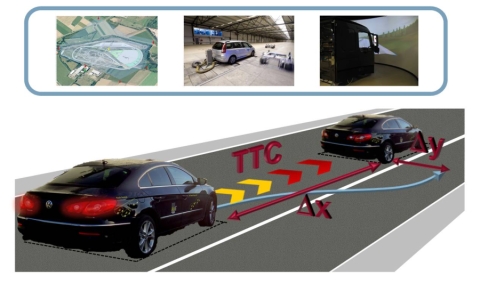evaluation and legal aspects
Evaluation provided a test and evaluation framework for the assessment of each interactIVe application with respect to human factors and technical performance. Also, test scenarios, concrete evaluation methods, and test procedures as well as tools for evaluation like equipment, test catalogues, procedures, questionnaires or software and support for testing have been provided. Test and evaluation criteria were defined. The corresponding legal aspects for broad exploitation of the applications have been analysed.

Update 4.0 (March 2013)
Evaluating function performance
As the project is approaching its final stage, the evaluation of the safety systems that have been developed has increased in importance. The inter�actIVe applications have been integrated into the demonstrator vehicles and tested in accordance with the test and validation plans developed by the �Evaluation and Legal Aspects� sub-project. The main objective of the evaluation is to assess how well the different interactIVe functions fulfil their objectives as specified in their target sce�narios. Hence, the functions have been evaluated from a development point of view rather than from a consumer point of view. The tests cover the following interactIVe target scenarios:
- Rear-end collisions
- Head-on collisions
- Blind-spot collisions
- Cross-traffic collisions
- Collisions with vulnerable road users
- Unintended lane departure accidents
- Excessive speed accidents and
- Traffic rule violations.
The first tests were conducted in July 2012 on Volkswagen�s outdoor test track in Wolfsburg (Ger�many) and in September 2012 at the TNO�s indoor testing facility, �VeHIL�, in Helmond (Neth�erlands). The rear-end collision scenarios and crossing traffic scenarios were tested on both the test track and in VeHIL. The tests for the SECONDS and INCA dem�onstrator vehicles are scheduled for the beginning of 2013 and are already ongoing. The results of the tests have been presented at the final event.

Testing collision mitigation functions at �VeHIL� indoor testing facility, in Helmond (Netherlands) in September 2012.
Update 3.0 (January 2012)
The sub-project �evaluation and legal aspects� has finalized the test and evaluation plan for interactIVe. The document describes the evaluation methodology for the technical, user-related and safety impact assessments in interactIVe. The used evaluation method is based on the evaluation method used in PReVAL, which has been updated for the interactIVe purpose. Furthermore the document includes detailed test plans for each of the seven interactIVe demonstrator vehicles. Therefore the sub-project �evaluation and legal aspects� has developed a comprehensive list of test cases considering different scenarios.
The project deliverable �Test and evaluation plan� will be available on the interactIVe webpage in autumn 2012.
Update 2.0 (November 2011)
On November 24th, 2011 a workshop on legal aspects was held at the Federal Highway Research Institute (BASt) in Bergisch Gladbach, Germany. Focusing on interactIVe applications aspects of vehicle type approval, road traffic law and product liability on EU level were discussed.
Basis for discussions were the project deliverable �Legal Aspects�. This document has been written by BASt and ika with regard to the legal framework for the developed interactIVe functions. The deliverable covers the vehicle type-approval for interactIVe functions according to relevant UN ECE regulations as well as the legal framework on EU-level with the focus on product liability and international law (Vienna Convention on Road Traffic).
The project deliverable �Legal Aspects� will is available on the interactIVe website.
Update 1.0 (May 2011)
During the latest workshop on evaluation in April 2011 in Brussels the participants dicussed the hypotheses for the interactIVe functions, which will be assessed. They had been defined by the sub-project evaluation and legal aspects in the deliverable �Specifications of the Evaluation Framework� based on the deliverable �Requirements for the Evaluation Framework�. Both documents are public and can be downloaded here.
The upcoming � also public � deliverable �Test and evaluation plan� will include a description of the methodology for the assessment and the test plans for the developed functions. One major challenge regarding the test plan is the reduction of the testing effort due to the high number of use cases and the different demonstrator configurations. It also needs to be ensured that all necessary data for a sufficient assessment are collected in the conducted tests.
Therefore the sub-project evaluation and legal aspects will elaborate the test cases together with the demonstrator vehicles building up sub-projects. Questions such as
- Where and which way � on a test track, in a driving simulator or even real traffic - are the tests performed?
- When will which function be tested and which equipment - available reference system, target objects - is needed?
- Who is performing which test?
have to be answered during the next steps.
![]() evaluation and legal aspects
evaluation and legal aspects

by the European Commission





